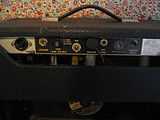Fender Princeton

The Fender Princeton was a guitar amplifier made by Fender. It was introduced in 1947 and discontinued in 1979.[1] After Fender introduced the Champ Amp in 1948, the Princeton occupied the next to the bottom spot in the Fender line. Fender Princetons (as well as their sister amp the Princeton Reverb) from the early models into the 1970s models are highly valued particularly as recording amplifiers.
The original Princeton used one 6SL7 dual-triode tube to provide two stages of RC-coupled voltage amplification in the preamplifier section. The power amplifier section used a single cathode-biased 6V6 beam power tetrode configured for Class A operation. The amplifier had a single volume control and a simple low-pass tone control to control treble response. In 1961 a new Princeton of fundamentally different design was introduced. This version used a single 7025 dual triode in the preamplifier; a 12AX7 dual triode, one half of which operated a tremolo oscillator and the other half of which served as a split-load phase inverter; and two 6V6GT tubes (again cathode biased) in Class AB push-pull configuration in the power section. A pull-out "boost" switch was added on the master volume pot in 1978.
It is particularly famous as the basis for Mesa Boogie's Mark I, which is a heavily hotrodded Princeton equipped with modified preamp and a Bassman transformer, allowing it a higher gain output of 60 watts.
In 2006, Fender revived the Princeton name, under "Princeton Recording-Amp" (Pro-tube series) and "Princeton 650" (under Dyna-touch III series). The Princeton recording amplifier is basically a blackface Princeton with built-in overdrive, compressor and power attenuator. Fender also reissued the Princeton Reverb in 2008.
-

Back panel of 1966 Fender Princeton amplifier
-

Princeton 1974/75
-

Back of 1974/75
See also
References
- ↑ Teagle, J. and Sprung, J.: Fender Amps: The First Fifty Years.
| |||||||||||||||||||||||